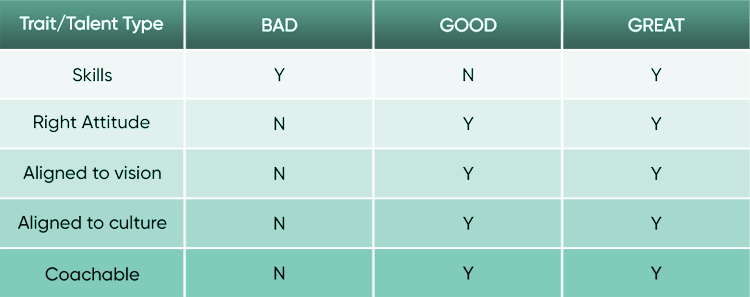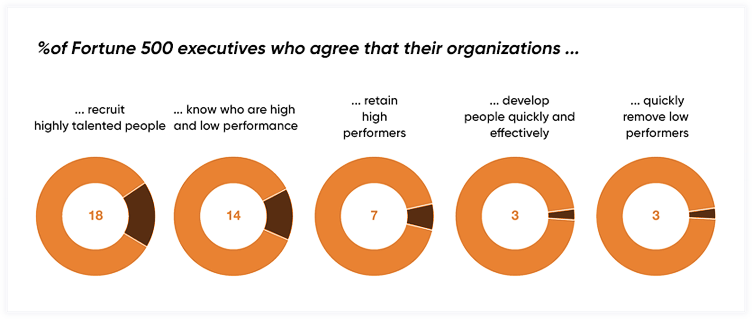Good To Great:
The Art Of Finding and
Retaining Talent
How can you hire, inspire, and retain the right talent to scale new heights in business success
Did you know a bad hire could cost you 30% of their first-year earnings?
Money is not all that you lose when you hire the wrong person. People who aren’t right for your business are disengaged. Disengagement is contagious.
Bad hires lower morale and productivity of other employees, essentially starting a chain reaction that could set you back considerably.
On the other hand, hiring a high performer can take your productivity through the roof. In highly complex roles high performers can be 800 percent more productive than average hires. Yes – EIGHT HUNDRED PERCENT.

Image Source: https://www.mckinsey.com/business-functions/organization/our-insights/attracting-and-retaining-the-right-talent
Identifying The Right Talent
Talent was a very different beast just a generation ago. Skills were the main criterion people were evaluated for. If you were good at what you did, no one cared much about you as a person. And it worked for that time. People kept work and life segregated.
That’s not how it is for millennials who are a majority of the workforce today. As seekers of talent, you need to dive in to the millennial mindset.
Millennials are always working, always connected. Work and life are integrated; the boundaries are blurred. It’s hard to separate one’s emotional being from the person that’s doing a certain job. So personalities matter. Attitudes matter. Skills – not so much.
To reflect that change, we need to look at candidates in a different way:

Good Hire – A good hire has the right attitude but not the skill. Why am I calling it a good hire then? Attitude alignment is a stronger trait. “Skill is overrated,” says Jeff Bezos, and I agree. If you have the right attitude, you can learn the skill. A good hire is coachable because they desire to do great things for the company.
Great Hire – Finally a great hire has both – the right attitude and the right skill. They love the company and what it stands for, they resonate with the company vision, and they are coachable. These are your rockstars.
How do you know what category is the person sitting across from you? How do you make the right choice and hire the great people?
Hiring to fit a certain company culture is one of the most difficult (and most important) things startup founders have to do. Here is how you can make it slightly easier for yourself and find the right candidates in the process:
Weed Out Undesirables:
Knowing what you don’t want will help you narrow down on the people you should talk to.
A well-structured pre-hire assessment can weed out random applicants and help you spend more time with candidates that are a better fit. A survey found that 78 percent of companies that invest in pre-hire assessments stated that employees meet or exceed performance goals.
Check References:
References are a great free tool to evaluate what the candidate is like in the workplace. There is very little you can judge in the few hours you spend interviewing a person, and they are putting their best foot forward.
Work Accomplished = Time Spent x Intensity
References give you insights into their day-to-day attitude and working style that could have a big impact on your hiring decision.
Go With Your Gut And When In Doubt – Don’t Hire:
Intuition is a great tool. If you feel any red flags while interviewing don’t ignore them. Don’t hesitate in saying no. If you can’t decide whether a candidate is a good hire or not, don’t hire. On the other hand, if a candidate feels like the right fit, mostly they will be.
Building a Culture of High Standards
You’ve hired some great people, now what? The biggest frustration of entrepreneurs is “I feel like I have hired someone really talented, but they are never able to meet my standards”.
What happens when the people you hire are not able to perform to the level you expect?

Should you not be holding them to your standards? Is it bad setting certain level of standards?
No. Absolutely not. As an entrepreneur, you must never negotiate on your standards.
At the same time, to ensure your standards are met, you need to understand and act on 3 things:
- 1Bridge the gap: The standard your employee delivers a task at may be different from what you expect. Not lower, just different. Their outcomes are based on their understanding. Often, fixing this is a simple matter of communicating your standards. Giving them an understanding of what you expect.
- 2Give time to catch up: While it’s a given that your standards need to be maintained, they are yours. Someone else can only learn them over a period of time. And are always rising. Your growth increases your standards. It’s hard for the other person to catch up. So you need to give them some time to catch up, and meanwhile train them so they can be up and running faster.
- 3Train for better outcomes: If you find the outcomes sub par, you need to train your people to deliver better. You need to give them a benchmark they need to aspire to. You need to talk to them and communicate your expectations clearly, while asking them what would help them meet those expectations.
But what are high standards and how do you sustain them in your business?
Jeff Bezos, in an annual letter to Amazon’s shareholders, shared his beliefs on what it takes to maintain consistently high standards.
- 1High standards are teachable – It may be hard to begin with, but once you build a culture of high standards, new entrants would adapt to that culture.
- 2High standards are domain specific – check for blind spots. You may have high standards in certain areas of business for example, innovation, but you may be sub-par in let’s say customer service.
- 3High standards must be recognized – to match something, you must first know what it looks like. Set out standards clearly, and if they aren’t describable, communicate examples of what they look like.
- 4High standards require realistic expectations – Asking an elephant to climb a tree is not going to go well for anyone. Convey realistic expectations and outline efforts involved in achieving it.
Do you see a pattern here?
COMMUNICATION is the most important element of the culture you are trying to build.
If you fail to communicate your vision, your expectations, your feedback, your people will not be able to meet your standards.
Retaining People Who Matter
If you thought hiring was difficult, think again. Developing and retaining the talent you have takes significant investment too.
In fact, only 7 percent of Fortune 500 companies are able to retain high performers. That’s a shockingly low number.

Image Source: https://www.mckinsey.com/business-functions/organization/our-insights/attracting-and-retaining-the-right-talent
Over three million Americans voluntarily leave their jobs each month – mostly because 70 percent of the US workers are disengaged from their jobs.
How do you keep your people engaged at work?
Simple, give them what they want.
We are living in the gig economy. Today’s workforce is all about working on their own terms. They need flexibility to work anytime, anywhere. They want a certain level of autonomy in their work. Give them these choices and see productivity and engagement shoot through the roof.
Another surefire way to keep high performers engaged is to challenge them – not to the point of burnout, but enough to give them a nice stretch.
Great talent loves action and the thrill of going after something.
Finally, people today want more from their jobs than just money. High performers especially want to work on things that excite them, things that will change the world, and things that they are passionate about. They want to chase a vision, and change the world.
Millennials are looking for a purpose and if you don’t provide it, they’ll look elsewhere.
It’s critical that you communicate your vision again and again. That you make your people feel a part of a bigger journey. That you make an effort to keep them engaged. When it comes to company culture, there are no quick fixes.
People are critical to the success of your vision. As Jim Collins said in his book Good to Great, “Great vision without great people is irrelevant” . To make your vision come true:
How have you invested in hiring and retaining the right people? We’d love to hear your stories.
Every year we select a few entrepreneurs to work with us to grow their companies while reducing the number of hours they invest working “in” the business. If this year if your year, if this is the year you will love to see extraordinary success for your business, we would be curious to see if we could help.
